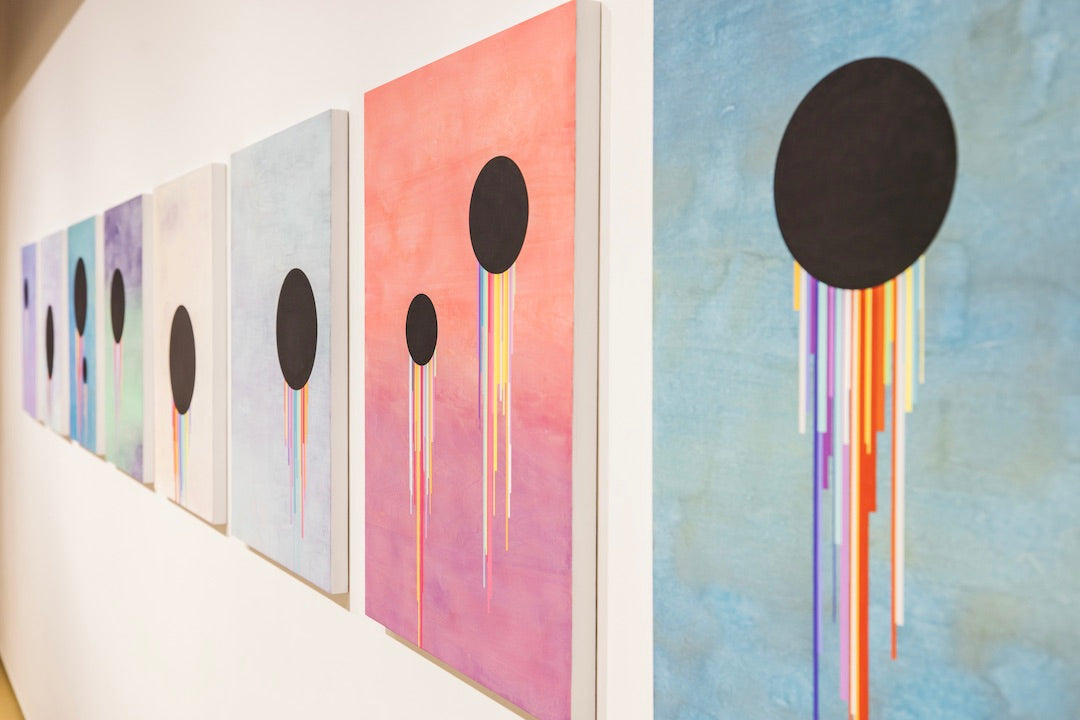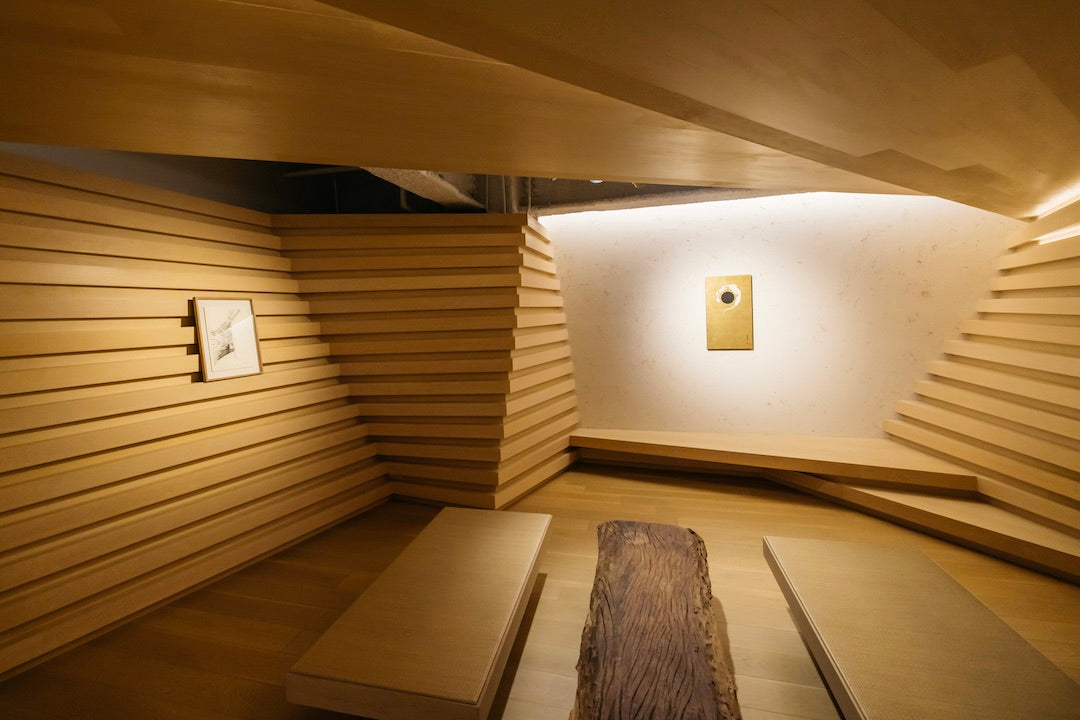ARTICLES
The Extravagant Art of Tenmyouya Hisashi | “BASARA CORE”: A Fusion of Figurative and Abstract
October 26, 2022
Taipei

Powerful gods and warriors of the mythical world, Edo Period samurais, and modern-day Sentai heroes. Such dynamic characters are the subject of Tenmyouya Hisashi's paintings that feature heroes from various times and places in traditional Japanese art. His solo exhibition entitled "BASARA CORE: The World of TENMYOUYA Hisashi" at Whitestone Gallery Taipei unveils his new "CORE" series that incorporates elements of abstract art.

Exhibition installation view
ー What is the meaning behind the exhibition title "BASARA CORE"?
Tenmyouya: The concept behind my artworks is "BASARA", which in a nutshell represents beauty "extravagantly, excessively, and destructively". It is my attempt to subvert the stereotypical image of Japan and create a new image based on the warrior-like culture of Japanese street art. At the same time, it’s an attempt to break down the barriers between contemporary art and Japanese art. “BASARA” is a statement of this intent.
However for this exhibition, I wanted to think outside the box and create dynamic and transformative pieces of art. In my opinion, most artists who have established their own style are constantly repeating that style until the end. It’s boring and established styles are meant to be torn down!
Artists should try to venture out of their comfort zones. This attitude in itself is “BASARA”, and the idea behind "BASARA CORE".

Exhibition installation view
ー What kind of influence does the new "CORE" series have on the BASARA aesthetics?
Tenmyouya: Up until now, “BASARA” has been my collective term for the unbroken lineage of extravagant and destructive beauty that has taken root in Japanese street art. “BASARA” is the raging god Susanoo of Japanese mythology, the self-indulgence of the Northern and Southern Dynasties Period, the kabukimono at the end of the Warring States Period, the eccentric painters of the Edo Period, as well as the godlike Godzilla of modern times.
I am incorporating concepts of Japanese abstract art like that of the Gutai and Mono-ha art movements. Through this, I am taking “BASARA” to a new level and strengthening the “BASARA” art concept. Besides abstract art, I plan to continue to incorporate new elements in “BASARA” to expand even further.

Tenmyouya Hisashi's "CORE" series, with its distinctive negative space. From left to right: "Blood", "Ha - Break", "Mirror".
ー What is your particular focus for this exhibition?
Tenmyouya: I have a different concept and depiction methods for every exhibition. It's not uncommon for many to think that a different artist painted the works for each exhibition. Though the depiction and concept may differ, I have consistently drawn heroic images in the context of Japanese art, whether it's the raging gods of the mythical world, armored warriors, Edo Period samurai, or modern-day Sentai heroes.
Among my works, many feature tattooed warriors and samurais. Tattoos generally have a negative image in Japan, but they are very popular in Western countries, where around 4 out of 10 people aged between 18 and 40 are inked.
Different countries have obviously very different ways of thinking. How my artworks are perceived is different overseas or in Japan. I look forward to seeing the visitor’s response in this exhibition.

Installation view of "BASARA Exhibit" (2010), Spiral Garden

Installation view of Tenmyouya Hisashi's "Kunitsukami" solo exhibition (2019), Mizuma Art Gallery
ー What is important to you when deciding on the direction of your artworks?
Tenmyouya: It's important for me to be innovative. Of course, it's also important that it aligns with my “BASARA” concept, but I always consider whether the step I'm taking is an innovation.

Tenmyouya working on a painting
ー For the “CORE” series in this exhibition, were there any works or artists that inspired you?
Tenmyouya: I’m inspired by various art genres and concepts. These include Japanese abstract art as epitomized by Gutai and Mono-ha, or Hieronymus Bosch's altarpieces, and Katsushika Hokusai's "A Tour of the Waterfalls" woodblock prints. Other sources of inspiration were the "Matrix" movies, the explosion scenes in the "AKIRA" manga, black holes, time streams, dimensional rifts, and pixel art.

Tenmyouya Hisashi "Japanese Spirit No. 18" (2015-2021), 200.0×92.0cm, black gesso/gold leaf/acrylic on wood
ー You mentioned that “BASARA” is an attempt to find a new identity for Japanese art. What is your idea of traditional Japanese culture?
Tenmyouya: I’d like for people to know more about Japanese traditional and contemporary culture.
This includes things like mono-no-aware (idiom for "an empathy toward things"), wabi-sabi (idiom for “beauty of imperfection”), Zen, and even Kawaii and Otaku culture. But Japan's identity is much more than that. While that simple, conventional image of Japan is part of the culture, Japanese culture also includes flamboyant festivals as well as stylish and lively traditions like Kabuki.
For example, Japan can be like the silent films of the world-renowned Yasujiro Ozu, but it can also be the intense splendor of Akira Kurosawa's "Ran".
I named my art concept "BASARA" from this vibrant, destructive, flamboyant and outrageous side of Japanese culture. Through my artworks, I hope people can learn about a different side of traditional and contemporary Japanese culture.

Exhibition installation view、Tenmyouya Hisashi "Pop-up Hyakki Yagyo on Rakuchu-Rakugaizu Screens" (2017)

Exhibition installation view
Tenmyouya Hisashi considers innovation to be the most important factor when he creates art. This exhibition features his new "CORE" abstract painting series and his iconic "BASARA" heroic paintings together in the same space for the very first time. We invite you to visit the gallery or see the online exhibition to experience the clash of the opposing sides that resonate in the figurative and the abstract, the classic and the novelty.